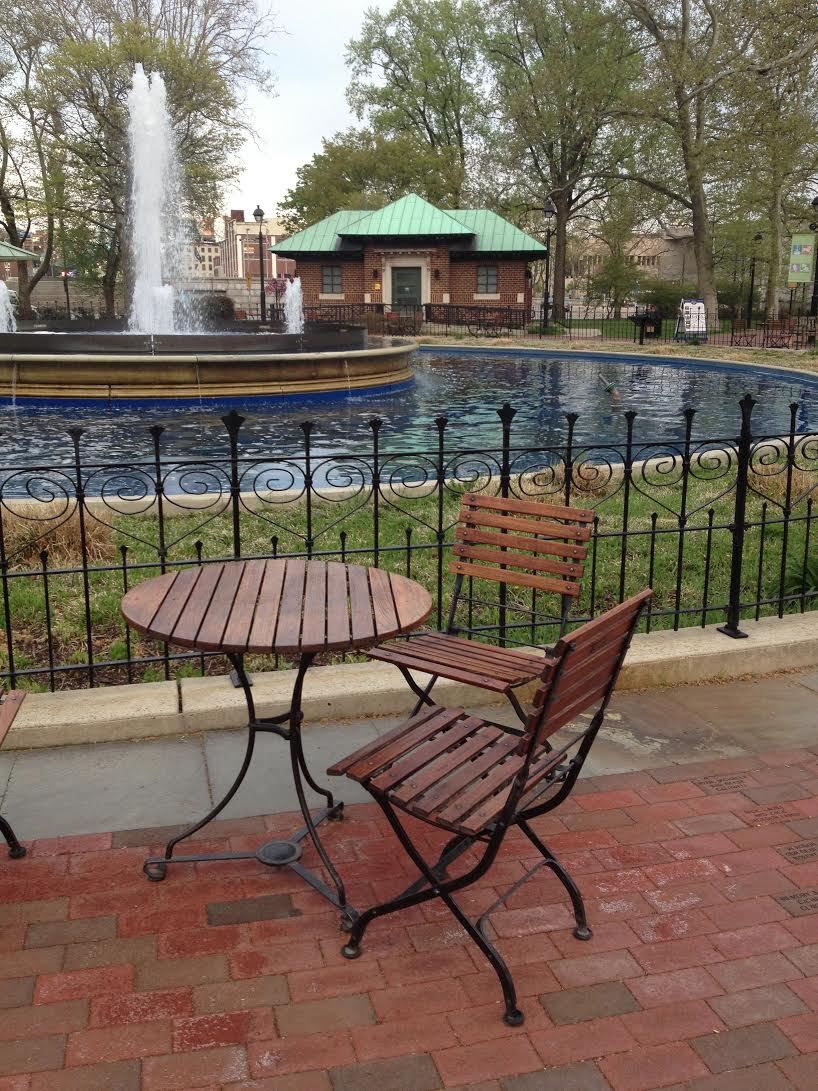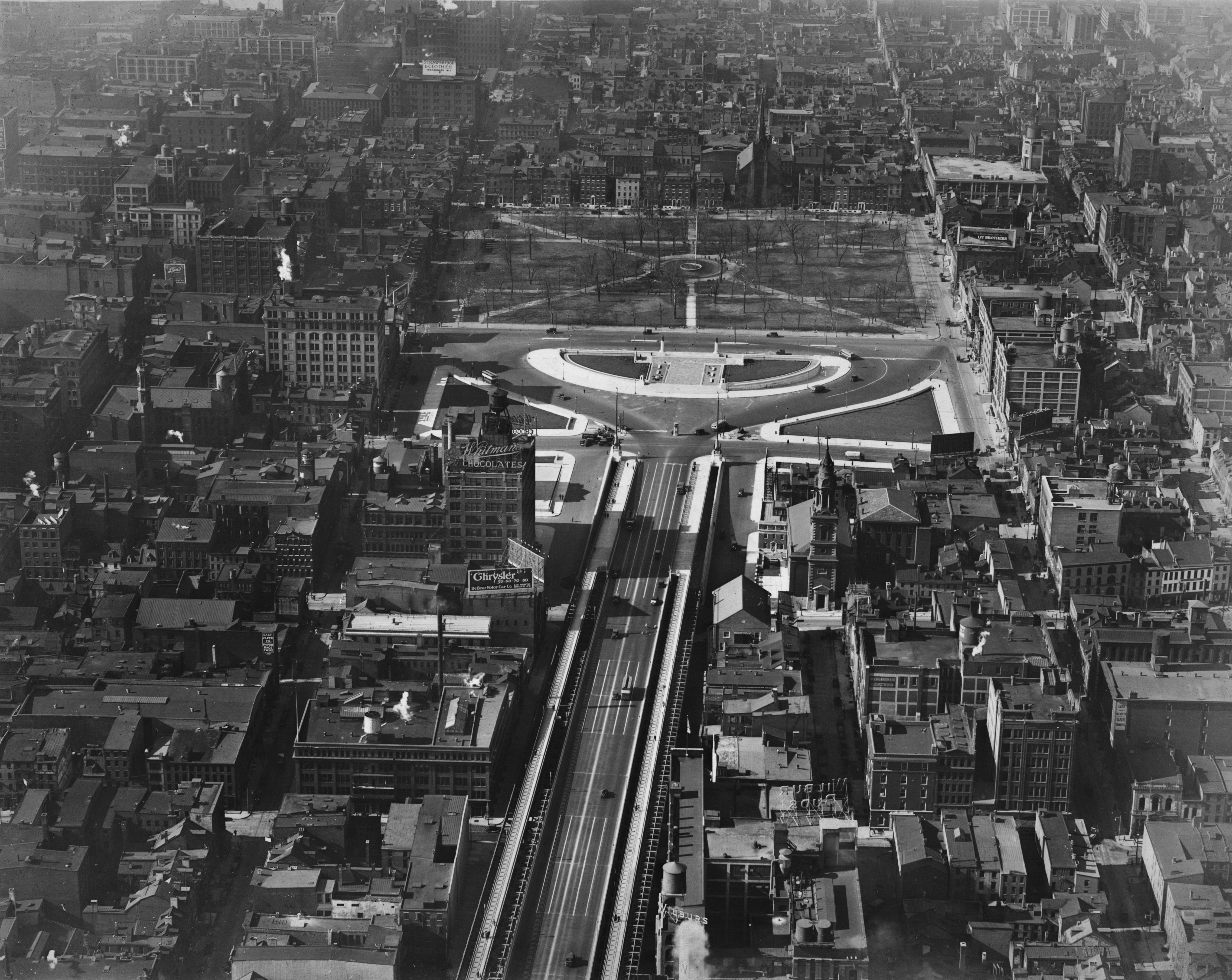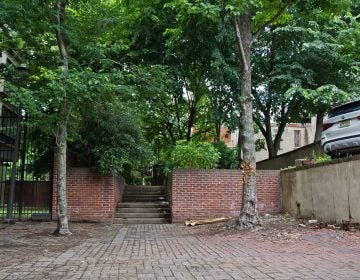On Franklin Square: From ‘Skid Row’ to fun zone

In celebration of what would have been Jane Jacobs’ 100th birthday on May 4, we’re taking a look at these four parks, past, present and future. What has remained the same, what has changed, and what is next for these spaces? We will also explore them in person in a pair of walks happening on Sunday, May 8th as part of this year’s Jane’s Walk weekend.
For most of the 20th century Franklin Square’s story was one of encroachment and erosion. First Benjamin Franklin Bridge construction removed buildings lining its eastern side, then the Vine Street Expressway trimmed off a corner. Urban renewal, practically a curse word to Jane Jacobs, enabled construction of Independence Mall, removing some of the density and variety that had once surrounded the blocks near Franklin Square. By 1960 Franklin Square was a park without constituents beyond people of “indigent leisure,” as Jacobs described in “The Death and Life of Great American Cities”.
“A good Skid Row park like Franklin Square has something to be said for it. Supply and demand have come together for once and the accident is clearly appreciated among those who have been disinherited by themselves or circumstance. In Franklin Square, if the weather permits, a day-long outdoor reception holds sway. The benches are the center of the reception are filled, with a voluble standing overflow milling about. Conversational groups continually form and dissolve into one another. The guests behave respectfully to one another and are courteous to interlopers too. Almost imperceptibly, like the hand of a clock, this raggle-taggle reception groups around the circular pool at the center of the square. And indeed, it is the hand of a clock, for it is following the sun, staying in the warmth. When the sun goes down the clock stops; reception is over until tomorrow.”
Jacobs goes one further: “This is not where you find drunks lying around with bottles in the morning. They are more apt to be in the city’s grand Independence Mall, a new vacuum uninhabited by any recognizable form of society, even Skid Row.”
That reputation held for decades.
When the non-profit Historic Philadelphia took over management of Franklin Square 10 years ago, there was grass and large trees in varying condition, but not much else to draw many people to the park.
“All of the lighting was broken, the gorgeous fountain in the center hadn’t worked since the bicentennial,” recalled Amy Needle, president and CEO of Historic Philadelphia. “The daycare center teachers who use it on a daily basis would come over in the morning and clean out the playground from all the needles and drug paraphernalia that were left from the night before so that the kids could play on the playground. It was a very sad place.”
Historic Philadelphia started by renovating Franklin Square’s good bones: fixing the fountain, doing tree work, upgrading the playground. That was followed by the carousel and landmark miniature golf, both envisioned as destinations that set Franklin Square apart. Other changes have been more iterative. The pavilion was built to support the rising demand for hosting events, and Square Burger was added because users wanted a place for quick refreshments.
Now instead of the leisured indigent, Needle explains, a day in the life of the park is varied. Now the day starts early: 5:30 a.m. Tai Chi with Chinatown neighbors, followed by daycare and pre-k groups, the stroller set, dogs and their people all mark the mornings. A lunchtime and after-school crowd keeps things moving. By night, it’s quiet, but activities like miniature golf draw dates. Birthday parties and temporary programming further provide animation. And then there are the tourists who visit too.
“When we opened, I think we thought that it would be much more of a tourist destination than it is. Historic Philadelphia also runs the Betsy Ross House and the Betsy Ross House is traditionally 80 percent tourist, 20 percent residential. At Franklin Square it’s the opposite, but we’re happy to have everybody. With events, however, like the Lantern Festival in celebrating Franklin Square’s 10th birthday, it is definitely a tourist destination. So far, in our first week of operation, we’ve had people from 43 states come in the evening to the festival. I don’t know if those people would come to Franklin Square.”
Programming, both permanent and temporary, can be a boon to parks without natural circulation and constantly varied use throughout the day, but too much and you drive away natural users. At Franklin Square, Historic Philadelphia is continuing to test a theory of park life Jacobs was silent on: using programming parks to draw users. Instead temporary events, from ballgames to plays, were what she deemed “demand goods” that could help resuscitate a park from the brink.
WHYY is your source for fact-based, in-depth journalism and information. As a nonprofit organization, we rely on financial support from readers like you. Please give today.







